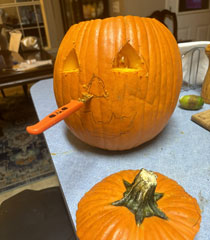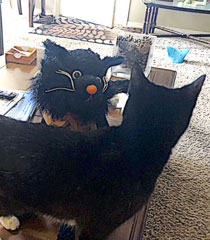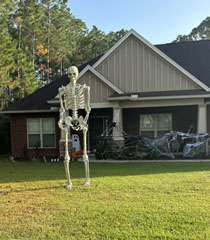 |
The Skarry Skelly 2024 Halloween Message |
|
Hey kids, forget the election. (As if you could.) And forget the Yankees. (The Dodgers sure could.) It's time for tricks and treats! And some more of life's insights from dad. (A parent's work is never done.) |
H
ow does this Halloween night differ from other Halloween nights? For the first time in four years, the National Retail Federation's Plan to Celebrate, Spending Per Person and Total Spending projections on its Halloween webpage are going down rather than up. Same thing happened in 2020, also a presidential election year. Those figures used to go up: they did in 2016 and in other election years going back to 2008. NRF doesn't publish figures farther back than that.
What's it mean? Maybe nothing. Just another tale told by another idiot, signifying nothing. Or maybe it's suggesting consumers are a little unsure and afraid, chastened by three and a half years of rising inflation and pulling in their horns a little. What if there is no tomorrow? This year's presidential election promises to be a real squeaker. And the stakes for our country couldn't be higher. Both sides are loud and clear that it's economic catastrophe if the other side wins. Trump in fact is insisting catastrophe is already here. Most economists don't agree with him, and it's not hard to see why. Annualized GDP for the third quarter is looking like around 3.2%. It was 3.0% in the second quarter. The year-to-year will be probably 2.5-2.7%, fairly far from catastrophic. Employment continues its strong run under Biden, growing by some 13.4 million jobs to date; unemployment is hovering in the 4% range. Inflation (2.2%) has returned to within a whisker of the Fed.'s 2% annual target. And wage growth is outpacing it. How's all this affect Halloween? Let's take a look. 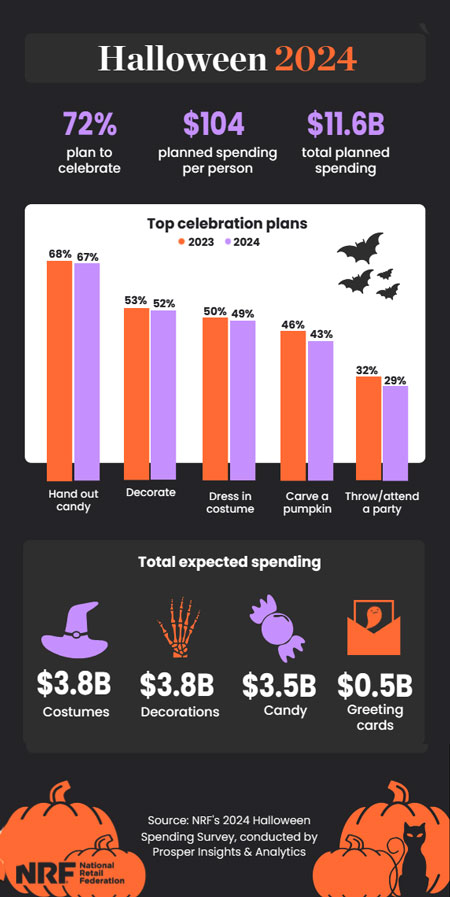
Well, they're not really that timid. It's really just the slightest haircut from last year (when those numbers were 73%, $108.24 and 12.2 billion respectively). So, any storm clouds gathering, really? Well yeah, a little bit. Those of you who actually read this page may recall a brief discussion last year about inverted yield curves. That's when longer-term government bond interest rates fall below shorter-term rates. In a well-ordered world longer-term instruments would offer a higher return because the longer tenor carries with it greater uncertainty. The more time, the more risk. Well, just as it was last year, the yield curve has been inverted most of this year, a VERY reliable leading indicator of a pending recession. In fact, the New York Fed's recession probability indicator currently sees a 58% chance of one before February 2025. But that's just the thing; it's been inverted ever since July 2022, a record. An inverted yield curve may have called all 10 recessions since 1955, but it's been premature on this one for over two years now. And anyway, it's a phenomenon more likely flashing when the Fed is raising interest rates. And all you news hounds know well that the Fed just lowered its Federal Funds Rate (the interest rate banks charge each other when they lend money overnight) by 50 basis points (a half a percent). And also raised the likelihood of further cuts at later meetings this year. What is more, in just this month the curve has actually turned positive, or "uninverted" itself, if only fractionally. So wouldn't that take us off the hook? Here's the problem with that. Very specifically, when the yield curve uninverts right before the Fed starts cutting interest rates, that also has been known to kick off a recession, and not long afterward. So it's a hard moment to savor. 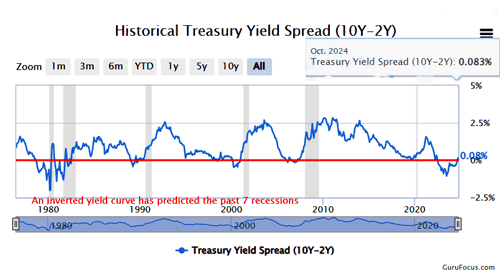
The Bureau of Economic Analysis (they track GDP) has already said it expects that next year's annual GDP rate will indeed be lower than this year's. How much lower? On the local front, neighborhoods around the Panhandle started decorating for Halloween earlier than usual this year. Usually a good sign for the economy. Oversize (10-15 feet tall) skeletons, zombies, chain saw murderers and grim reapers are a hot new trend here, punctuating lots of front yard displays this season. This just might be a good Halloween for democrats and for large extraterrestrials who've been wanting to pay a visit to Earth and walk around a few neighborhoods. Chances are, people might be so distracted by what's already on the ground, they won't even notice. Anyway, have fun tonight, guys. Try not to eat the chocolate you collect on your rounds right away. Chocolate prices have jumped by more than 40% since 2020, outpacing other food costs in terms of inflation. Might be wise to put it aside and wait for it to appreciate. One more piece of advice: whatever kinds of life forms you run into on the street, real or synthetic, try not to bring up politics this year. Whichever side you're on, the folks on the other are surely crazy. No telling what they'll do.
Love, Dad |
 websitesammy home page |
The All Saints’ Day celebration was also called All-Hallows or All-hallowmas (from Middle English Alholowmesse meaning All Saints’ Day) and the night before it, the traditional night of Samhain in the Celtic religion, began to be called All-Hallows Eve and, eventually, Halloween. ("Hallows" is Gaelic for Saints")
The immigrants celebrated as they did in their homelands—which often included pulling pranks. Common Halloween tricks included placing farmers’ wagons and livestock on barn roofs, uprooting vegetables in backyard gardens and tipping over outhouses. By the early 20th century, vandalism, physical assaults and sporadic acts of violence were not uncommon on Halloween.
By the time of the Great Depression in America, violence around Halloween—no doubt exacerbated by dire economic conditions—had reached new highs. Parents, concerned about children running amok on All Hallows' Eve, organized “haunted houses” or “trails” to keep them off the streets.
Around the time neighborhoods began organizing activities to keep kids safe and occupied, costumes became more important (and less abstract and scary). And take the form of characters from popular radio shows, comics and movies. In the '50s, mass-produced box costumes became popular, and trick or treaters began to dress up as princesses, mummies, clowns or more specific characters like Batman and Frankenstein’s monster.
In the mid-1980s, the Coors Brewing Company ran an ad campaign featuring TV horror host Elvira. It helped make the ghoulish night a “beer holiday” in the mold of Super Bowl Sunday and St. Patrick’s Day. Today Americans buy enough Coors beer at Halloween to increase seasonal sales by 10 percent.
Capitalizing on the party mood, retailers began pushing theatrical costume offerings: pin-up pirate, naughty nurse, even sexy Big Bird. Skimpy Halloween get-ups have long been available but in the last decade but now the prevalence of sexy costumes has exploded, according to Lesley Bannatyne, author of “Halloween Nation: Behind the Scenes of America’s Fright Night.”
Why the desire to flaunt so much skin for a celebration that comes around just when temperatures are taking a downward turn? “Whatever box you’re in, Halloween is when you get out of it, and for some, sexiness or outrageousness is their expression of getting out of it,” Bannatyne says.
Sue Mantz is an unhappy pumpkin


